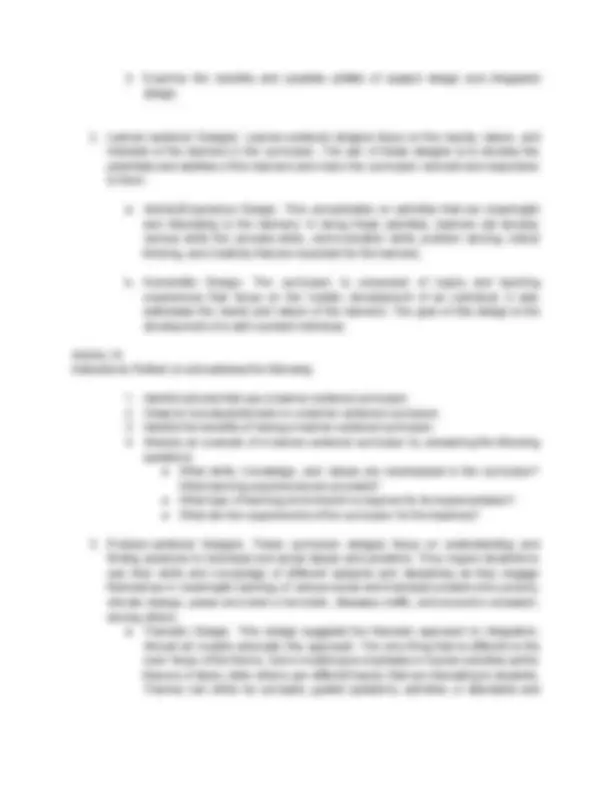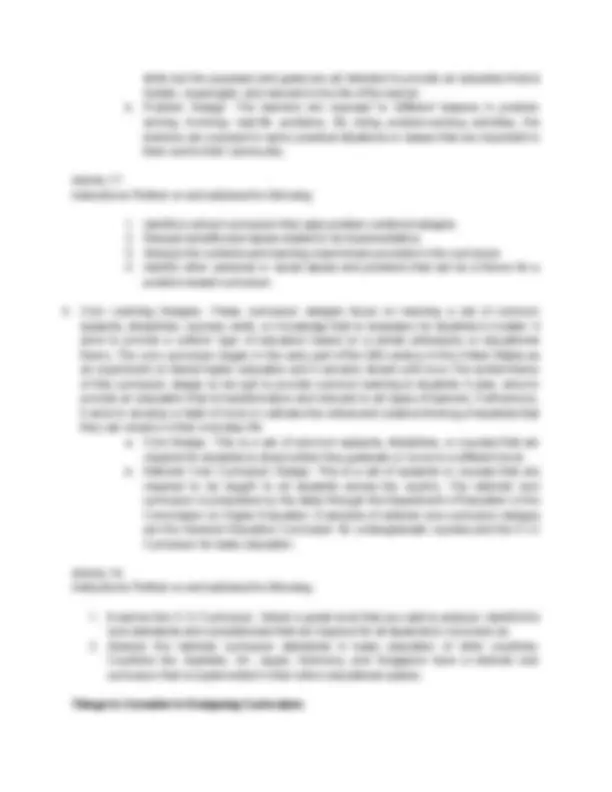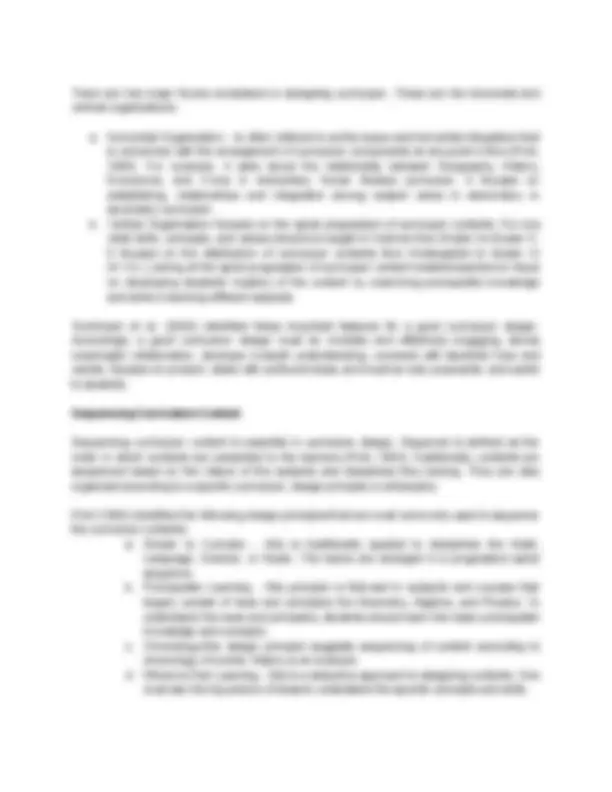





Study with the several resources on Docsity

Earn points by helping other students or get them with a premium plan


Prepare for your exams
Study with the several resources on Docsity

Earn points to download
Earn points by helping other students or get them with a premium plan
Community
Ask the community for help and clear up your study doubts
Discover the best universities in your country according to Docsity users
Free resources
Download our free guides on studying techniques, anxiety management strategies, and thesis advice from Docsity tutors
Curriculum design Education Planning And Management
Typology: Lecture notes
1 / 6

This page cannot be seen from the preview
Don't miss anything!




This chapter presents different curriculum designs identified by several practitioners and scholars in curriculum studies. The different curriculum designs provide an insight on how subjects and disciplines are organized into learning areas. In this chapter, you should be able to:
emphasized in the subject design. Instead, the nature of the subject is highlighted in this design to provide students with a general knowledge of each subject. Math Science Filipino English b. Academic Disciplines Design. Like the subject design, this type of design organizes the curriculum in terms of disciplines like Algebra, Physics, Chemistry, Literature, Economics, Philippine History, and other disciplines. This type of design is mostly used in high school or in college. The contents are highly specialized particularly at the college level. Biology Algebra Earth Science Economics c. Integrated Design.This curriculum design is based on the principle that learners learn in an integrated manner. Thus, this type of curriculum design tries to merge two or more related subjects. Basically, there are three types of integration: ❖ Interdisciplinary - includes the merging of two related disciplines or subjects. An example is the integration of Science and Health. Educators believe these two are naturally integrated. One needs science knowledge in order to understand health concepts. Science Health ❖ Multidisciplinary or broad fields - includes the integration of three or more related disciplines. An example is the Social Studies curriculum. This subject integrates civics, history, culture, and economics. Geography Civics and culture History Economics ❖ Core-requires that all subjects or disciplines in the school curriculum be put together using a single theme. Usually, this type of integrated curriculum design is used in preschool where subjects are combined using curriculum themes. Community Family Self Activity 15. Instructions: Reflect on and address the following:
skills but the purposes and goals are all intended to provide an education that is holistic, meaningful, and relevant to the life of the learner. b. Problem Design. The learners are exposed to different lessons in problem solving involving real-life problems. By doing problem-solving activities, the learners are exposed to some practical situations or issues that are important to them and to their community. Activity 17. Instructions: Reflect on and address the following:
There are two major forces considered in designing curriculum. These are the horizontal and vertical organizations. a. Horizontal Organization - is often referred to as the scope and horizontal integration that is concerned with the arrangement of curriculum components at any point in time (Print, 1993). For example, it asks about the relationship between Geography, History, Economics, and Civics in elementary Social Studies curriculum. It focuses on establishing. relationships and integration among subject areas in elementary or secondary curriculum. b. Vertical Organization focuses on the spiral progression of curriculum contents. For exa what skills, concepts, and values should be taught in Science from Grade I to Grade VI. It focuses on the distribution of curriculum contents from Kindergarten to Grade 12 (K-12). Looking at the spiral progression of curriculum content enables teachers to focus on developing students' mastery of the content by examining prerequisite knowledge and skills in learning different subjects. Tomlimson et al. (2002) identified these important features for a good curriculum design. Accordingly, a good curriculum design must be mentally and affectively engaging, allows meaningful collaboration, develops in-depth understanding, connects with students' lives and worlds, focuses on product, deals with profound ideas, and must be real, purposeful, and useful to students. Sequencing Curriculum Content Sequencing curriculum content is essential in curriculum design. Sequence is defined as the order in which contents are presented to the learners (Print, 1993), Traditionally, contents are sequenced based on the nature of the subjects and disciplines they belong. They are also organized according to a specific curriculum. design principle or philosophy. Print (1993) identified the following design principles that are most commonly used to sequence the curriculum contents: a. Simple to Complex - this is traditionally applied to disciplines like Math, Language, Science, or Music. The topics are arranged in a progressive spiral sequence. b. Prerequisite Learning - this principle is followed in subjects and courses that largely consist of laws and principles like Geometry, Algebra, and Physics. To understand the laws and principles, students should learn the basic prerequisite knowledge and concepts. c. Chronology-this design principle suggests sequencing of content according to chronology of events. History is an example. d. Whole-to-Part Learning - this is a deductive approach to designing contents. One must see the big picture of ideas to understand the specific concepts and skills.